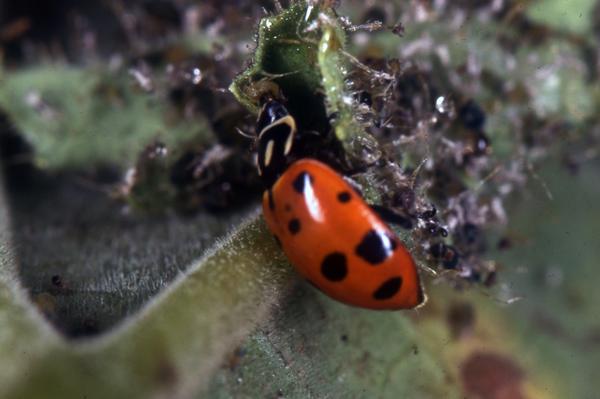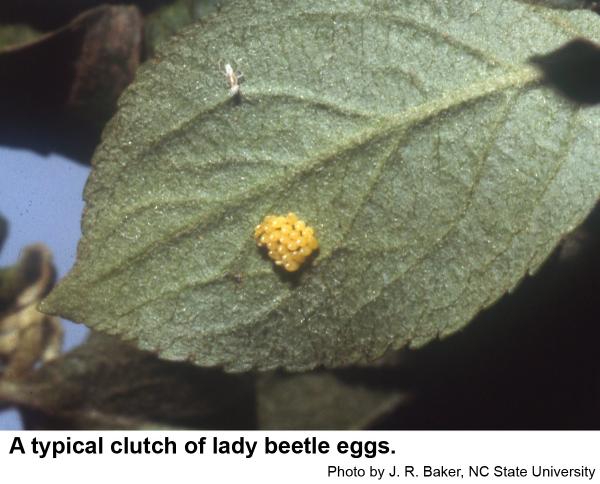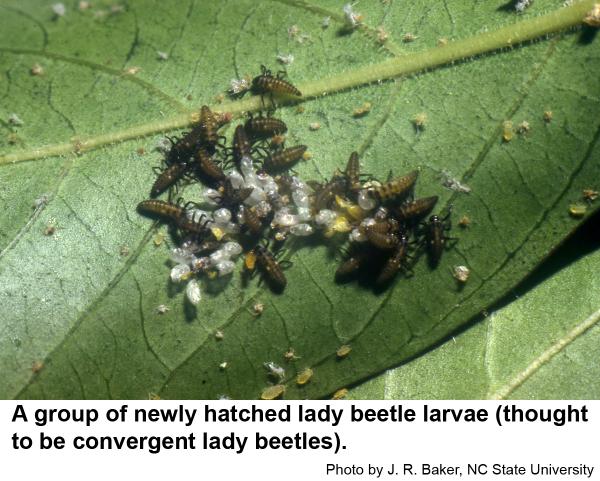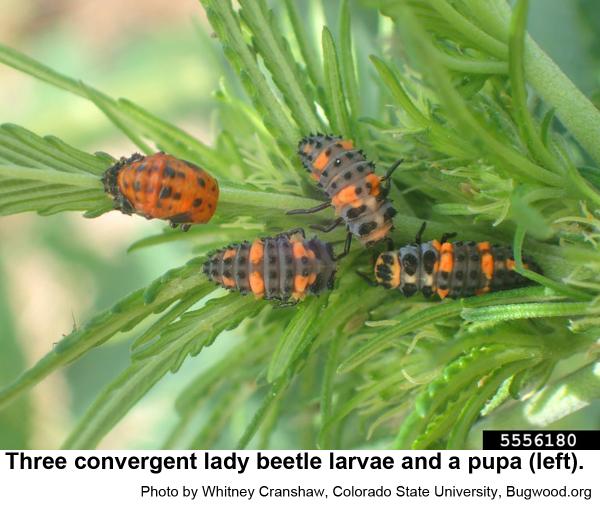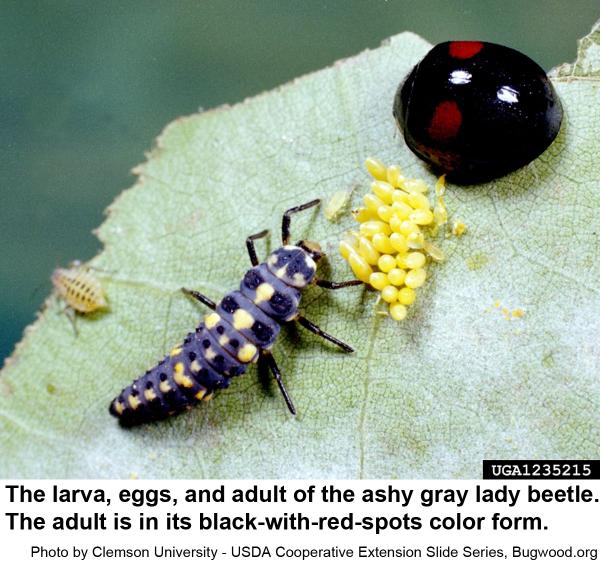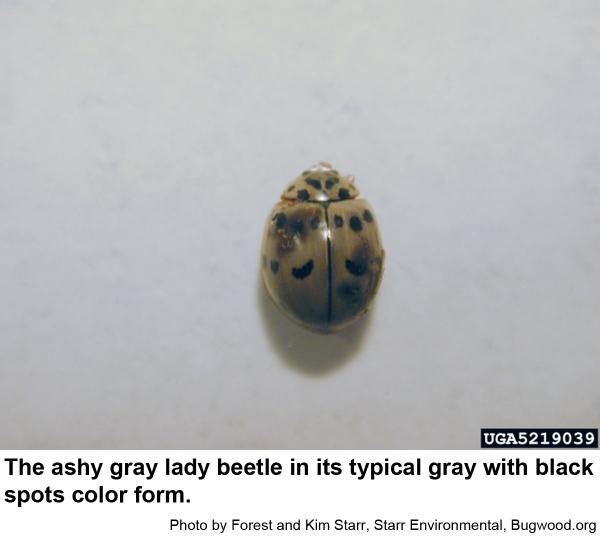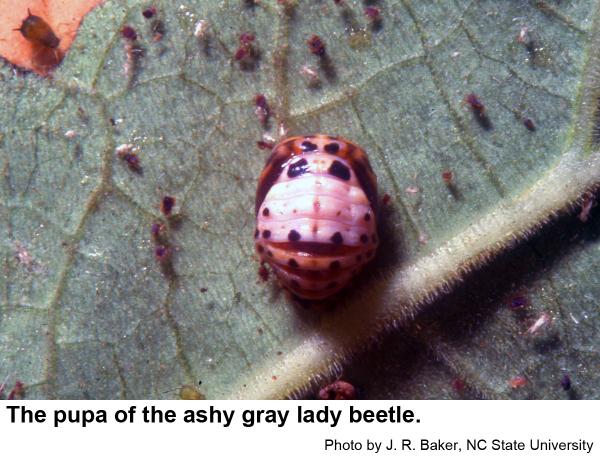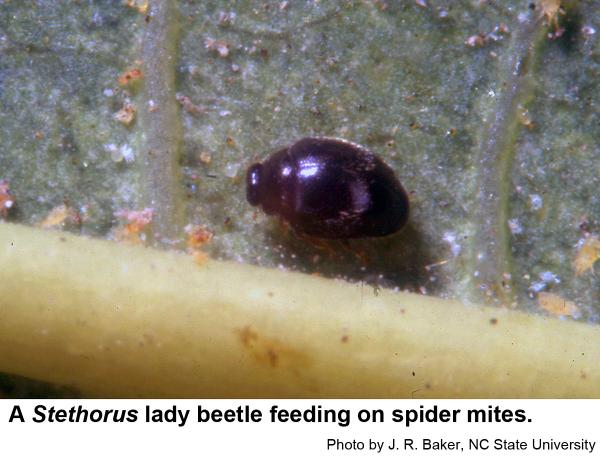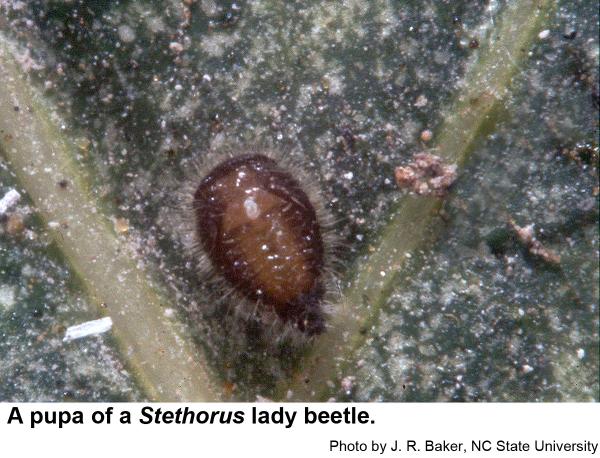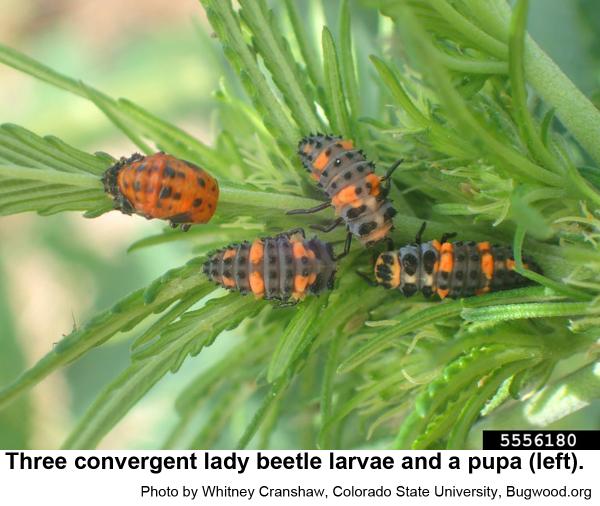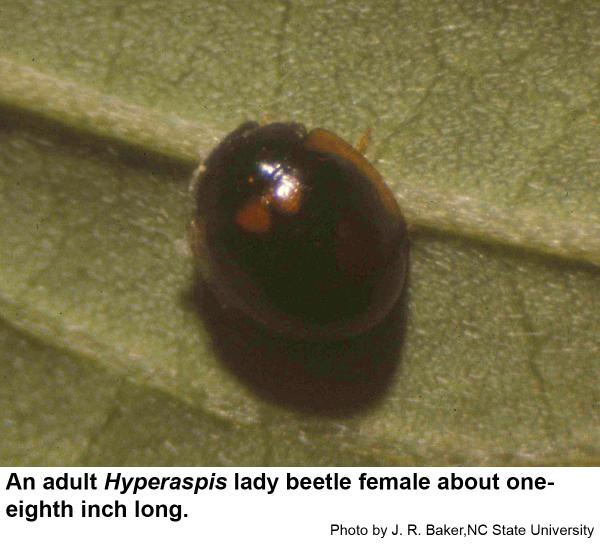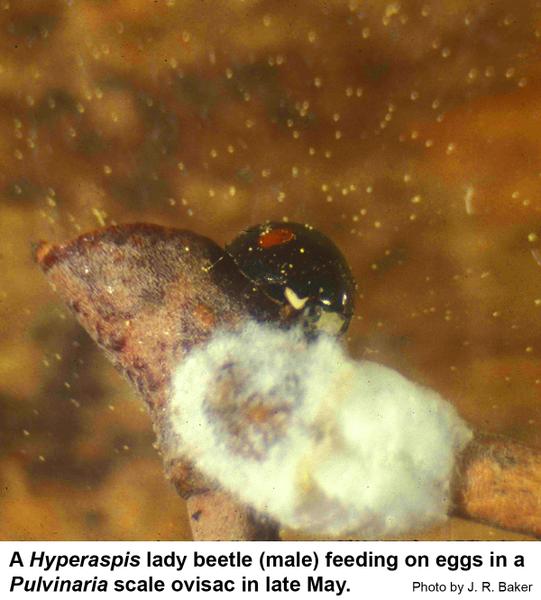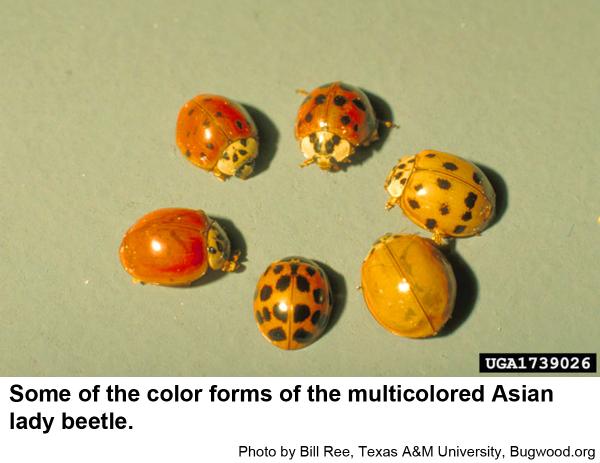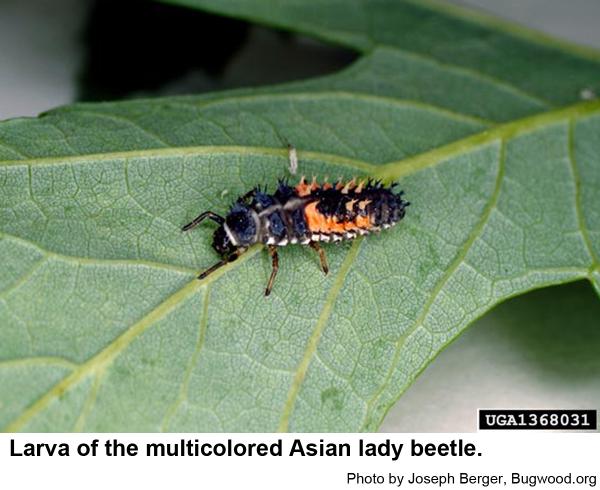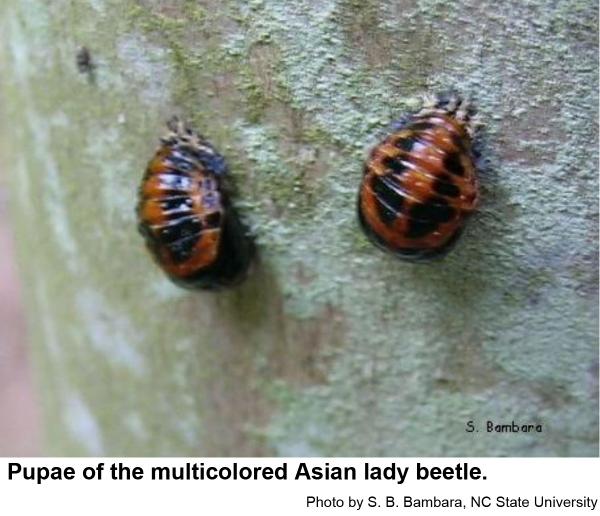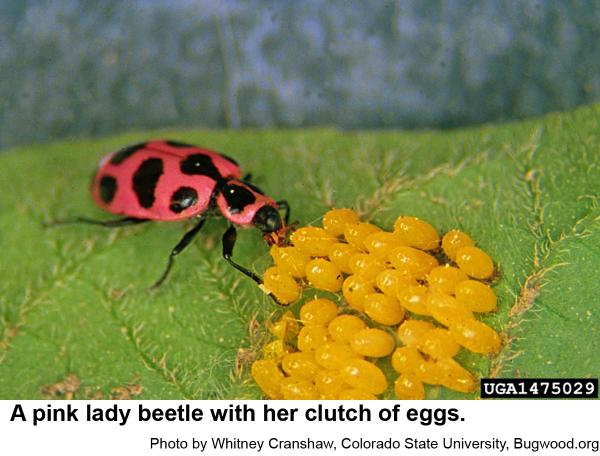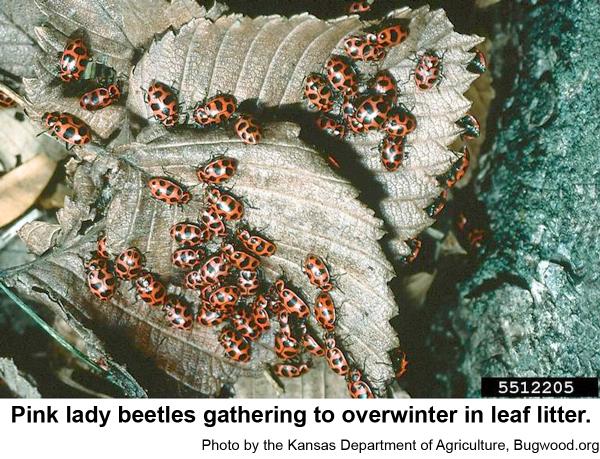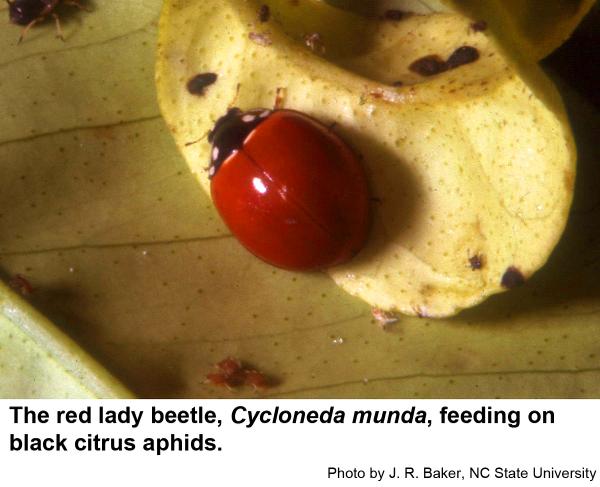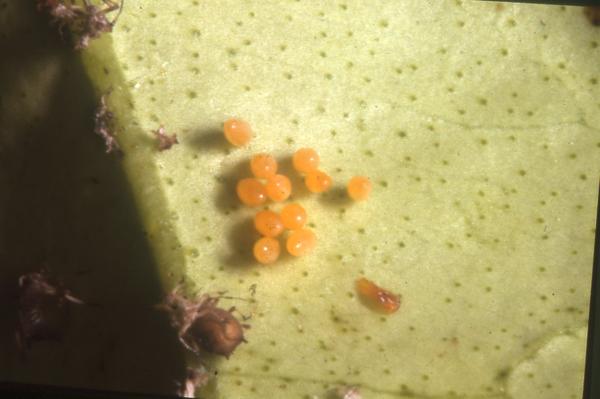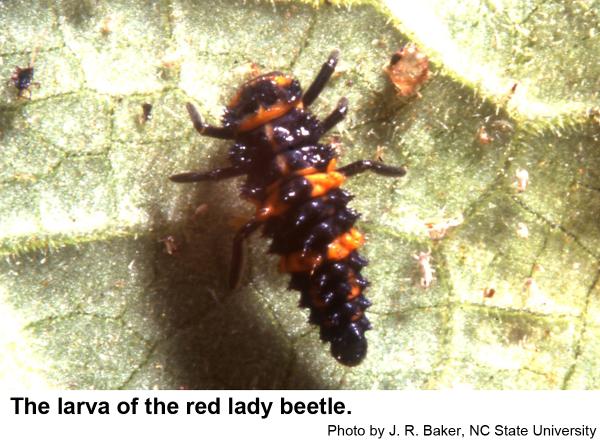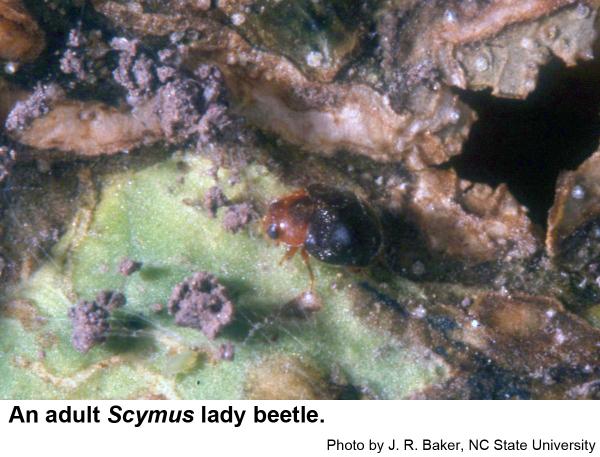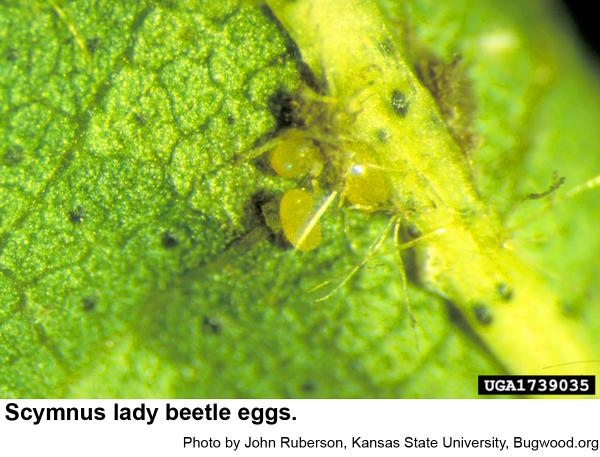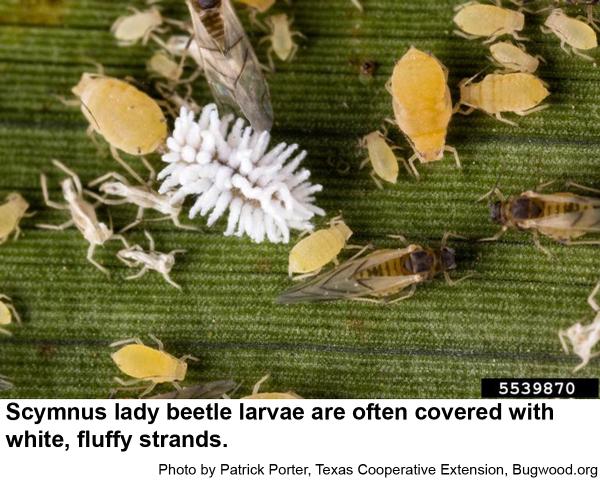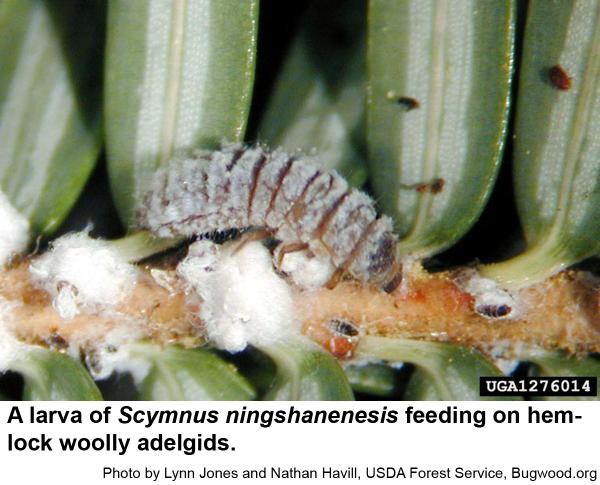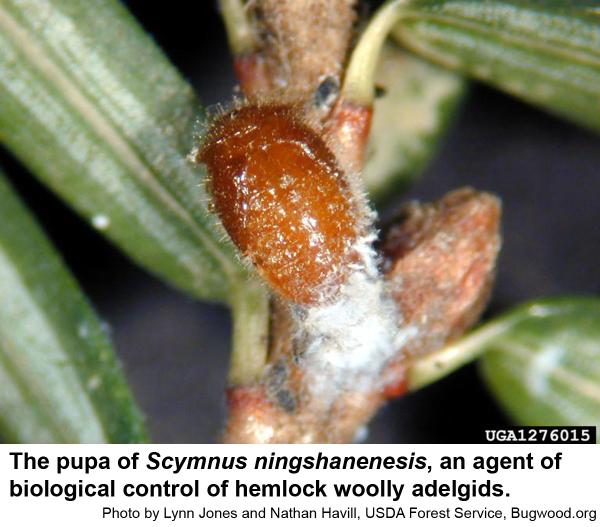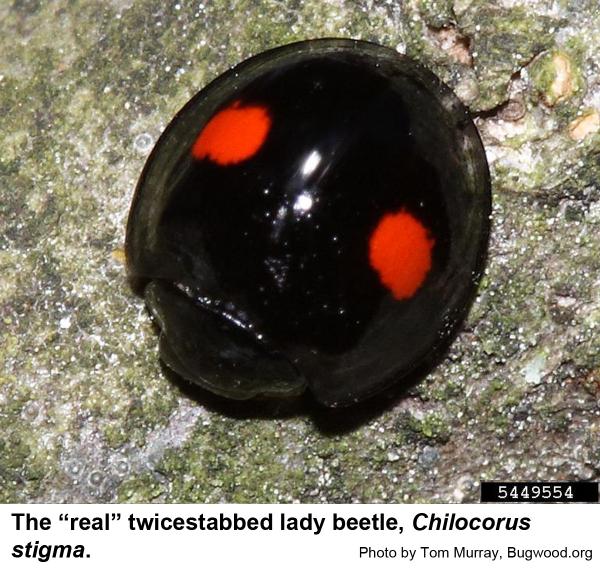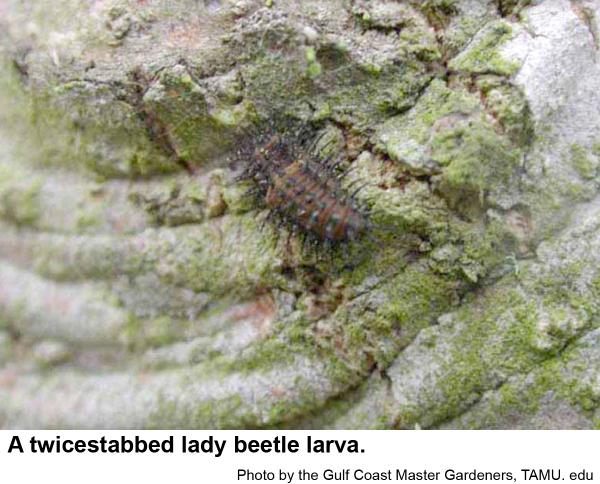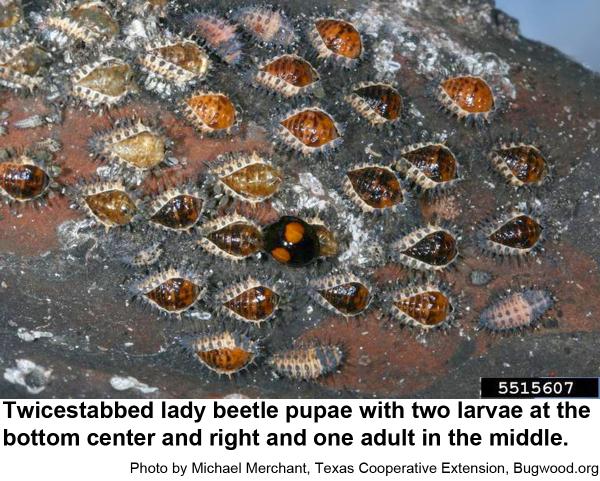General Information
Lady beetles are oval, almost hemispherical insects that are often shiny and contrastingly colored. Many species are red with black spots or black with red spots. A few species are gray with black spots or orange or brown. Most lady beetles are 1⁄4 inch or smaller and some are quite tiny.
The eggs of some lady beetles are yellow and less than 1⁄16 inch long. They are often laid on end in small masses. The eggs of others are scale-like and laid flat on twigs. From the eggs hatch larvae, small insects that resemble tiny, short-snouted alligators with six legs. Some lady beetles have larvae covered with a fluffy white secretion which makes the insect look like a mealybug. The next stage is the pupa. Pupae are about the size of the adults, but the legs and antennae are closely pressed to the body. Also, the wing buds wrap around the body. The pupae are usually anchored to the substrate by the rear.
Because lady beetle pupae do not resemble the adults (or anything else in the home gardener's experience) the many gardeners assume that lady beetle pupae are pests "sucking the life" out of the plant. Consequently, these pupae are squashed or scraped off and destroyed. Each lady beetle larva eats many aphids and other pests, and each lady beetle lays many eggs which would hatch into many more larvae. Each pupa destroyed allows thousands of aphids to survive!
Biology
Lady beetles are found throughout the United States. Except for the Mexican bean beetle and the squash beetle, all other American species of lady beetles feed on aphids, scale insects, mealybugs, spider mites, and other plant pests. Except for the Mexican bean beetle and the squash beetle, lady beetles do not damage plants although some species feed on pollen when prey is scarce.
Also called ladybirds and ladybugs, lady beetles are regarded with more popular affection than any other beetle. Eggs are laid near aphids, scale insects, or spider mites. After hatching, the tiny lady beetle larvae feed on nearby plant pests. The larvae molt several times as they grow. Finally, the last stage larvae fastens itself by the rear end to a leaf or twig and then pupates. The pupae develop for several days. New lady beetles then emerge from the pupal stages.
In the fall, adult lady beetles seek a dry, sheltered overwintering site. The following spring the lady beetles disperse to find plant pests for food and oviposition (egg laying) sites. In North Carolina, lady beetles overwinter in small groups (rarely up to 300 to 400 individuals). In western states, lady beetles congregate by the millions along mountain ridges. Thus it is possible for collectors to scoop bushels of lady beetles to sell to home gardeners for aphid control. To reach their hibernation site, western lady beetles have to fly for long distances. Consequently, when they leave the overwintering site in spring, they instinctively fly for long distances to reach a source of aphids or other host insects.
Ashy Gray Lady Beetle
Ashy gray lady beetles, Olla v-nigrum, prey on the eggs and larvae of beetles and moths and on aphids in arboreal plants. This is a relatively large lady beetle that has two color forms: ashy-gray with black spots and shiny black with two red spots. Females lay about a dozen eggs per egg mass that hatch about 3 days later. Larvae molt four times as they mature and pupate 8 days later. New adults emerge 6 days later. Development from egg to adult usually takes 15 to 17 days although it may take longer in cool weather.
Black Lady Beetle
The black lady beetle, Stethorus picipes, and other species of Stethorus are small lady beetles that prey chiefly on mites. Unfortunately, black lady beetles generally do not appear on plants until mite populations are quite high. The distribution of black lady beetles is patchy, and they cannot be relied upon to maintain spider mites at a low level for long. Eggs are gray, tiny and spindle shaped. They are laid singly in mite colonies. Larvae are about 1/20 inch long and dark brown to black with short spines. Pupae are mahogany colored and usually attached to a leaf. Adults are very small (1/25 inch long), black and covered with silvery hairs.
Convergent Lady Beetle
Convergent lady beetles, Hippodamia convergens, feed on aphids, scales, thrips, and other soft-bodied insects that are too slow to get out of the way. They also feed on pollen and nectar from flowers when prey is scarce. Even though they can survive on pollen, females must consume aphids or other live prey to reproduce. Each female lays 200 or more eggs in her life time. Developmental time from egg to adult takes about 21 days. Even though they are voracious predators, lady beetles are themselves preyed upon by generalist predators such as large big-eyed bugs and damsel bugs that feed on the eggs in particular. A tiny wasp, Dinocampus coccinellae, has been found parasitizing convergent lady beetles. We have two generations per year here. In California convergent lady beetles congregate in the mountains to overwinter in masses so large that they are harvested and kept in cold storage for later sales. Each spring the remaining beetles fly back into the valleys to resume feeding and laying eggs.
Hyperaspis Lady Beetles
Hyperaspis lady beetles are tiny, black, oval insects that have various red or orange spots on the wings and thorax. They are adapted to feeding on the egg masses of scale insects that lay their eggs in a dense, cottony mass (called the ovisac). These lady beetles appear about the time the scales start to lay their eggs. The lady beetles lay their own eggs on bark or leaves nearby the scale ovisacs. From the lady beetle eggs hatch tiny grayish larvae that start to feed on the eggs of the scales. As the lady beetle larvae grow, they secrete a dense, white, fluffy covering which makes these lady beetle larvae resemble mealybugs. In a few weeks, mature larvae fasten themselves to leaves by the hind end and then pupate. Ten or so days later another generation of lady beetles emerges. These beetles evidently go into aestivation in some sheltered place. These are unusual lady beetles in that they seem to have a long resting stage that lasts from late spring to the following early spring. Perhaps this is an adaptive strategy to decrease exposure to tiny wasp and fly parasites that plague other lady beetles. Waiting until late June or early July to treat for scale insects that lay their eggs in cottony ovisacs should avoid killing Hyperaspis lady beetles before they leave for their aestivating/overwintering sites. This also gives surviving soft scale eggs time to hatch and for the crawlers to be exposed on leaves and twigs where they will be much more susceptible to insecticide sprays.
Multicolored Asian Lady Beetle
A recently introduced species called the multicolored Asian lady beetle, Harmonia axyridis, sometimes congregates in large numbers inside of houses in the fall and is considered a pest in that situation. The multicolored part of its common name refers to the great variety of color forms from almost black to pale orange. These beetles are usually marked with a variable number of spots. The larvae are remarkable for sixteen double pronged yellow-orange bumps on the abdomen. Multicolored Asian lady beetles eat many kinds of soft bodied insects, and is considered an important predator of aphids and scale insects. One downside is that it may be displacing some of our native lady beetle species. Eggs hatch in 5 days, and larvae develop for about 10 days. The pupal stage lasts at least 4 days. Development from egg to adults takes 3 to 4 weeks. In fall, these beetles seek out walls and other flat surfaces that face south. Sometimes the number of Harmonia lady beetles congregating on the sides of houses during warm fall days can be overwhelming. As the day cools, they burrow into cracks and crevices and make their way indoors. New females overwinter (without mating) along with the aggregate population. Mating occurs later the next spring.
Pink Lady Beetle or Spotted Lady Beetle
Pink or spotted lady beetles, Coleomegilla maculata, are consummate aphid predators but also prey on mites, insect eggs, and small larvae. Unlike most lady beetles, plant pollen may constitute up to 50% of the diet. Adults overwinter in large aggregations beneath leaf litter and stones along hedgerows or in protected sites along crop borders, especially those of fields planted to corn in the previous season. They emerge from early to mid-spring and disperse, often by walking along the ground, to seek prey and egg laying sites in nearby crops.
Females lay from 200 to more than 1,000 eggs over a one to three month period commencing in spring or early summer. Eggs are usually deposited near prey such as aphids, often in small clusters in protected sites on leaves and stems. Larvae grow from about 1 mm to 5 or 6 mm in length and may wander up to 40 feet in search of prey. The larva attaches itself by the abdomen to a leaf or other surface to pupate. The pupal stage may last from 3 to 12 days depending on the temperature.
Pink lady beetles may be found from April to late September and are usually be the most commonly observed lady beetles in corn, potatoes, and mixed crops. They may be especially abundant towards the end of the season when the adults aggregate in preparation for mating and winter hibernation. There are from two to five generations per year.
Red Lady Beetle or Polished Lady Beetle
Red lady beetles, Cycloneda munda, are shiny enough to appear polished. The forewings are uniformly red, and the thorax and head are black with white markings. Females lay yellow to orange oval eggs in clusters on leaves or stems. Eggs hatch into black larvae with contrasting orange markings. They develop through four stages in 12 to 16 days before pupating. Pupae can be found on plant leaves and stems. New adults emerge 4 to 10 days later. These beetles overwinter as adults in leaf litter. Red lady beetle larvae and adults feed on aphids, mites, caterpillars, insect eggs, and other soft-bodied insects.
Scymnus Lady Beetles
The lady beetle genus Scymnus includes many species of small, black, brown, mottled or spotted insects. The larvae are usually covered with a white wax and are often mistaken for mealybugs. They feed on mealybugs, scale insects, aphids, red spider mites, and insect eggs. Adults are about 1/12 inch long. Scymnus ningshanenesis is an important biological control agent of the hemlock woolly adelgid. Scymnus loewii is known as the dusky lady beetle.
Twicestabbed Lady Beetle
Twicestabbed lady beetle, Chilocorus stigmata, are relatively large, shiny black insects with two bold, red spots on their forewings. The cactus lady beetle, Chilocorus cacti, is also called the twicestabbed lady beetle. Cactus lady beetles have larger spots and occur in the very southern United States. This color scheme is shared with other beetles in the genus Chilocorus as well as lady beetles in several other genera. Two species, Chilocorus kuwanae and Chilocorus bipustulatus, have been introduced for biological control of armored scale insects such as the euonymus scale. However, the native twicestabbed lady beetle is the only Chilocorus that occurs throughout most of the United States. It is an voracious predator of several scale insects, aphids, and mealybugs. The twicestabbed lady beetle completes two generations in the North whereas in Florida, it can complete several generations a year. In cold areas, overwintering adults become active in early spring (April or May). Mating begins shortly and continues for about three weeks. Eggs are laid soon afterwards. Larvae emerge in late May and undergo four instars before pupating. Overwintering adults continue to feed through June and early July, after first generation larvae have hatched. First generation adults mature in early to mid July. Mating and oviposition continue as before, and second generation larvae are observed beginning in mid July through early August. Adults emerge in midsummer and overwinter in ground litter.
Purchasing Lady Beetles for Insect Control in the Landscape and Garden
Purchasing lady beetles for insect control is not recommended for several reasons. Although lady beetles are helpful and cute, they are not clever. Thus when lady beetles from California are released into a North Carolina landscape, the beetles instinctively fly for long distances in search of aphids and other plant pests as though they were still in California leaving the mountains for the valleys far away. The home gardener who releases a quart of lady beetles may never see them again. At least some satisfaction will be gained by helping to control aphids in someone else's garden.
A conundrum of using lady beetles is that if one waits until aphids are in the home grounds before ordering the lady beetles, naturally occurring lady beetles, predaceous syrphid fly maggots, parasitic wasps and fungal pathogens may deplete the aphids by the time the lady beetles arrive. On the other hand, ordering the lady beetles in expectation that aphids will invade the home grounds may mean that the lady beetles arrive before the aphids so that there is nothing for them to feed on. They will certainly fly away. Some shipments of lady beetles have also been found to have beetles that are already parasitized. Parasitized beetles usually have a short life and no reproductive capacity. However, if the reader persists in purchasing lady beetles to be released in the home grounds, the following may help keep the lady beetles in the vicinity:
-
It helps to have a raging population of aphids on which to unleash the lady beetles.
-
Always release the lady beetles in the evening when the weather is cooler.
-
Sprinkle the area with water where the beetles are released.
-
Sprinkling artificial diet in the area may entice the beetles to stay put.
Lady beetles and diets are sold by various horticultural supply houses, but the benefit of purchased lady beetles may not justify their cost.
Other Resources
Biology and fertility life table of Eriopis connexa, Harmonia axyridis and Olla v-nigrum (Coleoptera: Coccinellidae). Zazyckia, L. C. F. et al. 2015. Biology of Coccinellidae species. Braz. J. Biol. 75 (4),: 969-973
Biology of Scymnus ningshanensis (Coleoptera: Coccinellidae): A Predator of Adelges tsugae (Homoptera: Adelgidae). Montgomery, M. et al. 2002. In: Onken, B.; Reardon, R.; Lashomb, J., eds. The hemlock woolly adelgid in the eastern United States symposium; 2002 February 5-7. East Brunswick, NJ. New Jersey Agricultural Experiment Station and Rutgers University: 181-188.
Chilocorus stigma (Say), (Coleoptera: Coccinellidae) In Biological Control In A guide to Natural Enemies in North America. Shelton, A. No Date. Cornell University College of Agriculture and Life Sciences.
Coleomegilla maculata, (Coleoptera: Coccinellidae) In Biological Control In A guide to Natural Enemies in North America. Shelton, A. No Date. Cornell University College of Agriculture and Life Sciences.
Common name: convergent lady beetle, scientific name: Hippodamia convergens Guérin-Méneville (Insecta: Coleoptera: Coccinellidae). Aristizábal L. F. and S. P. Arthurs. 2014. Featured Creatures, Entomology & Nematology, FDACS/DPI, EDIS. Publication Number: EENY-592
Common name: ladybirds, lady beetles, ladybugs [of Florida], scientific name: (Insecta: Coleoptera: Coccinellidae). Frank, J. H. and Russell F. Mizell, III. 2014 (revision). Featured Creatures. Entomology & Nematology, FDACS/DPI, EDIS. Publication Number EENY-170.
Cycloneda munda. Hupman, K. 2015. BugwoodWiki.
Development and Reproduction of Olla v-nigrum (Coleoptera: Coccinellidae) Fed Anagasta kuehniella (Lepidoptera: Pyralidae) Eggs Supplemented with an Artificial Diet. BRAGA DA SILVA1,Da Silva, B. et al. 2013. Florida Entomologist, 96(3):850-858.
Lady Beetles. Newton, B. 2004. Kentucky Critter Files, University of Kentucky Entomology. University of Kentucky College of Agriculture Cooperative Extension Service.
Lady beetles. Anonymous. 2018 (copyright). Tree Fruit Research & Extension, Orchard Pest Management Online. Washington State University.
Multicolored Asian Lady Beetle. Jacobs, S. B. (updated). 2017. College of Agricultural Sciences Cooperative, Extension Entomological Notes, PennState University..
- See more lady beetle photos by Debbie Roos
- NC State Extension Plant Pathology Publications
- NC State Extension Horticultural Science Publications
- North Carolina Agricultural Chemicals Manual
For assistance with a specific problem, contact your local Cooperative Extension center.
Publication date: May 1, 1997
Reviewed/Revised: Nov. 17, 2020
N.C. Cooperative Extension prohibits discrimination and harassment regardless of age, color, disability, family and marital status, gender identity, national origin, political beliefs, race, religion, sex (including pregnancy), sexual orientation and veteran status.

